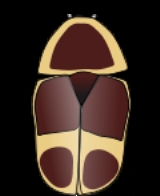
Pachnoda marginata
Encyclopedia
Pachnoda marginata is a beetle from the subfamily Cetoniinae with a large number of subspecies that lives in west and central Africa
. They are sometimes used as food for terrarium animals. The adult beetles are 20-30 mm, the larva
e are very small when they hatch, but can grow as long as 60 mm.
and two spots on each elytra
on each wing.
Sometimes the spots on the elytra are almost unnoticeable, as they seem to blend in with the rest of the body, this can be seen in the picture on the bottom left of Pachnoda marginata peregrina in the terrarium under "As pets".
The larvae of the pachnoda can make a low snore-like noise when making his cocoon.
in moist ground, which hatches after a short time into a larva
that feeds voraciously. When the larva
has matured, it pupates
, and then transforms into an adult beetle.
also eat leaves and other plant waste.
Africa
Africa is the world's second largest and second most populous continent, after Asia. At about 30.2 million km² including adjacent islands, it covers 6% of the Earth's total surface area and 20.4% of the total land area...
. They are sometimes used as food for terrarium animals. The adult beetles are 20-30 mm, the larva
Larva
A larva is a distinct juvenile form many animals undergo before metamorphosis into adults. Animals with indirect development such as insects, amphibians, or cnidarians typically have a larval phase of their life cycle...
e are very small when they hatch, but can grow as long as 60 mm.
Description
The sun beetle comes in nine subspecies, the three common ones are: Pachnoda marginata aurantia, Pachnoda marginata marginata, Pachnoda marginata peregrina, with ranging colors. Pachnoda marginata aurantia comes from orange to a yellow-orange, some having a hue gradient towards the middle seen in diagram below. Pachnoda marginata marginata normally is red or crimson with little change between individuals. Pachnoda marginata peregrina, the more common amongst the subspecies, is a pale yellow or orange with brown spots; one spot being on the thoraxThorax
The thorax is a division of an animal's body that lies between the head and the abdomen.-In tetrapods:...
and two spots on each elytra
Elytron
An elytron is a modified, hardened forewing of certain insect orders, notably beetles and a few of the true bugs ; in most true bugs, the forewings are instead called hemelytra, as only the basal half is thickened while the apex is membranous...
on each wing.
Sometimes the spots on the elytra are almost unnoticeable, as they seem to blend in with the rest of the body, this can be seen in the picture on the bottom left of Pachnoda marginata peregrina in the terrarium under "As pets".
The larvae of the pachnoda can make a low snore-like noise when making his cocoon.
List of the described subspecies
|
Life cycle
After mating, the female lays an eggEgg (biology)
An egg is an organic vessel in which an embryo first begins to develop. In most birds, reptiles, insects, molluscs, fish, and monotremes, an egg is the zygote, resulting from fertilization of the ovum, which is expelled from the body and permitted to develop outside the body until the developing...
in moist ground, which hatches after a short time into a larva
Larva
A larva is a distinct juvenile form many animals undergo before metamorphosis into adults. Animals with indirect development such as insects, amphibians, or cnidarians typically have a larval phase of their life cycle...
that feeds voraciously. When the larva
Larva
A larva is a distinct juvenile form many animals undergo before metamorphosis into adults. Animals with indirect development such as insects, amphibians, or cnidarians typically have a larval phase of their life cycle...
has matured, it pupates
Pupa
A pupa is the life stage of some insects undergoing transformation. The pupal stage is found only in holometabolous insects, those that undergo a complete metamorphosis, going through four life stages; embryo, larva, pupa and imago...
, and then transforms into an adult beetle.
As pets
Pachnoda marginata is an easy beetle to keep, requiring a terrarium with a lid (as it can fly out), a layer of moist ground, something to climb on, a warming lamp and food like bananas, apples and other fruits. The larvaLarva
A larva is a distinct juvenile form many animals undergo before metamorphosis into adults. Animals with indirect development such as insects, amphibians, or cnidarians typically have a larval phase of their life cycle...
also eat leaves and other plant waste.
External links
- Pachnoda marginata aurantia photos at Beetlespace.wz.cz
- Pachnoda marginata marginata photos at Beetlespace.wz.cz
- Pachnoda marginata peregrina photos at Beetlespace.wz.cz

